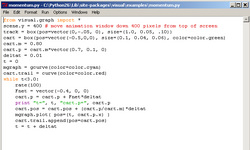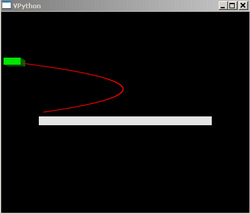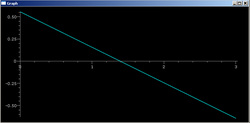Very Physically Physical Physics
Vpython Momentum Lab
Here, you can see the code that goes into this animation:
**It's tough to read, so the code is as follows:
from visual.graph import *
scene.y = 400 # move animation window down 400 pixels from top of screen
track = box(pos=vector(0,-.05, 0), size=(1.0, 0.05, .10))
cart = box(pos=vector(-0.5,0,0), size=(0.1, 0.04, 0.06), color=color.green)
cart.m = 0.80
cart.p = cart.m*vector(0.7, 0.1, 0)
deltat = 0.01
t = 0
mgraph = gcurve(color=color.cyan)
cart.trail = curve(color=color.red)
while t<3.0:
rate(100)
Fnet = vector(-0.4, 0, 0)
cart.p = cart.p + Fnet*deltat
print "t=", t, "cart.p=", cart.p
cart.pos = cart.pos + (cart.p/cart.m)*deltat
mgraph.plot( pos=(t, cart.p.x) )
cart.trail.append(pos=cart.pos)
t = t + deltat
from visual.graph import *
scene.y = 400 # move animation window down 400 pixels from top of screen
track = box(pos=vector(0,-.05, 0), size=(1.0, 0.05, .10))
cart = box(pos=vector(-0.5,0,0), size=(0.1, 0.04, 0.06), color=color.green)
cart.m = 0.80
cart.p = cart.m*vector(0.7, 0.1, 0)
deltat = 0.01
t = 0
mgraph = gcurve(color=color.cyan)
cart.trail = curve(color=color.red)
while t<3.0:
rate(100)
Fnet = vector(-0.4, 0, 0)
cart.p = cart.p + Fnet*deltat
print "t=", t, "cart.p=", cart.p
cart.pos = cart.pos + (cart.p/cart.m)*deltat
mgraph.plot( pos=(t, cart.p.x) )
cart.trail.append(pos=cart.pos)
t = t + deltat
Below is the end position of the cart(green box) off of the track (white box). The red parabola represents the path of the cart from the track to its resting position.
This graph shows the cart's momentum in respect to time during the animation. You may refer to the raw data in the following word document. (It is in small font and in two collumns as an attempt to reduce the length of the document.)
| momentum_vs_time_data.docx |
Answers to provided questions:
(1) Using the printed list of momentum vectors, calculate p:
delta(p) =p(final) - p(initial)= <?,?,?> kg m/s
<-0.644, 0.08, 0> - <-0.64, 0.08, 0>
= <-0.004, 0, 0> kg m/s
(2) Calculate the vector F(net)delta(t)
(In the program, this would be Fnet*deltat.)
= < -0.4, 0, 0>N *0.01s = <--0.004, 0, 0>Ns
(3) Do your calculations show that the change in momentum p is equal to F(net)delta(t)
Yes! When one cosiders their numbers and units (kg m/s = Ns), the values are the same.
(4) Look at the printed list of momentum vectors again. Why aren’t the y or z components of the momentum
changing?
Momentum is mass*velocity. Mass is never changing, and the velocity is only ever moving in the x axis in respect to time since it's moving on a horizontal surface.
delta(p) =p(final) - p(initial)= <?,?,?> kg m/s
<-0.644, 0.08, 0> - <-0.64, 0.08, 0>
= <-0.004, 0, 0> kg m/s
(2) Calculate the vector F(net)delta(t)
(In the program, this would be Fnet*deltat.)
= < -0.4, 0, 0>N *0.01s = <--0.004, 0, 0>Ns
(3) Do your calculations show that the change in momentum p is equal to F(net)delta(t)
Yes! When one cosiders their numbers and units (kg m/s = Ns), the values are the same.
(4) Look at the printed list of momentum vectors again. Why aren’t the y or z components of the momentum
changing?
Momentum is mass*velocity. Mass is never changing, and the velocity is only ever moving in the x axis in respect to time since it's moving on a horizontal surface.



